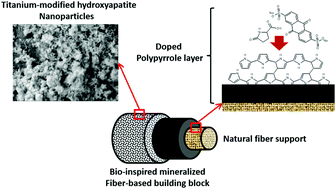Biomineralization of a titanium-modified hydroxyapatite semiconductor on conductive wool fibers†
Abstract
Metal ions are frequently incorporated into crystalline materials to improve their electrochemical properties and to confer new physicochemical properties. Naturally-occurring phosphate apatite, which is formed geologically and in biomineralization processes, has extensive potential applications and is therefore an attractive functional material. In this study, we generate a novel building block for flexible optoelectronics using bio-inspired methods to deposit a layer of photoactive titanium-modified hydroxyapatite (TiHA) nanoparticles (NPs) on conductive polypyrrole(PPy)-coated wool yarns. The titanium concentration in the reaction solution was varied between 8–50 mol% with respect to the phosphorous, which led to titanate ions replacing phosphate in the hydroxyapatite lattice at levels up to 17 mol%. PPy was separately deposited on wool yarns by oxidative polymerization, using two dopants: (i) anthraquinone-2,6-disulfonic acid to increase the conductivity of the PPy layer and (ii) pyroglutamic acid, to reduce the resistivity of the wool yarns and to promote the heterogeneous nucleation of the TiHA NPs. A specific titanium concentration (25 mol% wrt P) was used to endow the TiHA NPs on the PPy-coated fibers with a desirable band gap value of 3.68 eV, and a specific surface area of 146 m2 g−1. This is the first time that a thin film of a wide-band gap semiconductor has been deposited on natural fibers to create a fiber-based building block that can be used to manufacture flexible electronic devices.



 Please wait while we load your content...
Please wait while we load your content...